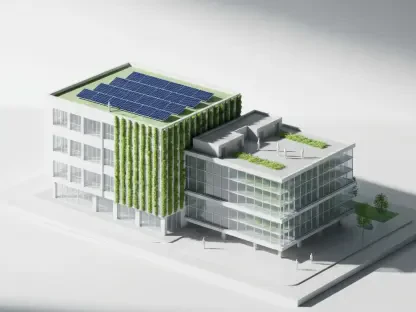The signing of the $3.4 trillion federal budget law by President Donald Trump marks a pivotal moment for the construction sector in the United States. This legislation presents a myriad of opportunities and challenges for contractors, centering primarily around tax relief and strategic operational modifications. With an emphasis on stimulating growth and securing a stable financial environment, the law provides contractors with essential tools to navigate the current economic landscape. However, it also leaves certain demands unaddressed, particularly in areas where future sustainability and infrastructure funding continue to provoke concern.
Financial Incentives and Tax Relief
Enhanced Stability Through Tax Deductions
Central to the budget law is the emphasis on tax relief aimed at galvanizing investment and expansion within the construction industry. This relief is primarily anchored in the continuation of the 199A Qualified Business Income Deduction, forestalling a possible 20% tax increase that loomed for many firms by 2026. This adjustment brings significant comfort to contractors, offering them predictability and allowing for strategic financial reinvestments. By providing certainty in tax policies, businesses can pursue more robust growth paths without the looming threat of increased taxation, fostering a more amicable environment for broader industry advancements.
Improved Depreciation Policies for Equipment
Another substantial facet of the budget relates to depreciation policies concerning construction equipment. The introduction of 100% bonus depreciation stands out, as it allows for immediate depreciation of both new and used equipment, a practice that had been eroding and was slated to phase out by 2027. This shift facilitates the acquisition and upgrading of machinery, enabling contractors to align more closely with modern technological demands. Further amplifying this benefit is the elevation of Section 179 expensing limits, which expands the fiscal viability of essential investments in construction technology and infrastructure, fortifying the sector against inevitable operational shifts.
Workforce Development Initiatives
Removing Tax Barriers on Overtime Pay
To nurture workforce development integral to the construction sector’s growth, the budget law introduces innovative measures that alleviate financial burdens on workers. Notably, federal income taxes are now exempt on overtime pay, providing an attractive incentive for employees to engage in extended working hours. This change not only enhances the immediate earning potential for workers but also contributes to a more dynamic and responsive workforce. By alleviating overtime taxation, the law incentivizes skilled tradesmen to maximize their output, driving productivity and supporting industry growth in ways that previously faced financial constraints.
Expanded Access to Education Resources
Complementing the overtime pay relief, the legislation extends educational resources through modifications to 529 savings accounts and Pell Grants. 529 accounts have been broadened to include funding for technical and skilled trades education, reflecting the budget’s commitment to fostering a skilled labor force. Similarly, the expansion of Pell Grants to encompass short-term workforce programs addresses a critical need for accessible training. By investing in educational initiatives, the budget promotes the development of competencies essential for sustaining construction efforts, equipping trade professionals with the knowledge and skills crucial to adapting to industry demands.
Unmet Needs and Emerging Challenges
Highway Trust Fund Concerns
Despite its numerous provisions, the budget law has not fulfilled all aspirations posited by contractor groups, notably in funding infrastructure projects. The absence of a new revenue stream for the Highway Trust Fund via electric and hybrid vehicle fees remains a contentious issue. Although garnering support from Republican circles, the proposal stalled in the Senate, leaving the fund’s reliance solely on traditional fuel tax revenues. This limitation hampers the potential for expansive highway and infrastructure projects, demanding alternative solutions to secure sustainable funding. It reflects a broader challenge, as the sector must reconcile existing funding structures with evolving vehicular trends.
Curtailment of Clean-Energy Incentives
The budget also delineates a gradual reduction in incentives geared toward clean-energy construction efforts. This includes phasing out tax benefits for energy-efficiency upgrades and eliminating credits for renewable-energy components and facilities. While it enhances traditional construction endeavors, this shift reveals gaps in environmental sustainability emphasis, potentially complicating contractor efforts to comply with emerging eco-friendly standards. The gradual disappearance of these incentives necessitates strategic adaptation and advocacy, compelling contractors to balance immediate growth potential with long-term ecological commitments—an equilibrium crucial for future-proof industry practices.
Addressing Future Legislative Directions
The enactment of the $3.4 trillion federal budget law by President Donald Trump heralds a significant turning point for the construction industry in the United States. This monumental legislation opens up a range of opportunities and hurdles for contractors, mainly revolving around adjustments in tax reliefs and operational strategies. Focused on igniting economic growth and ensuring financial stability, the law equips contractors with vital resources for maneuvering through the current economic challenges. However, it’s not without its shortcomings, particularly in addressing ongoing issues concerning the sustainability of future projects and infrastructure funding, which remain points of worry for many in the sector. The law aims to create a robust framework for development yet neglects certain pressing demands that could affect long-term planning and investment. Consequently, contractors are called to strategically adapt, leveraging available advantages while staying vigilant to potential unresolved roadblocks that could impact their future operations.









